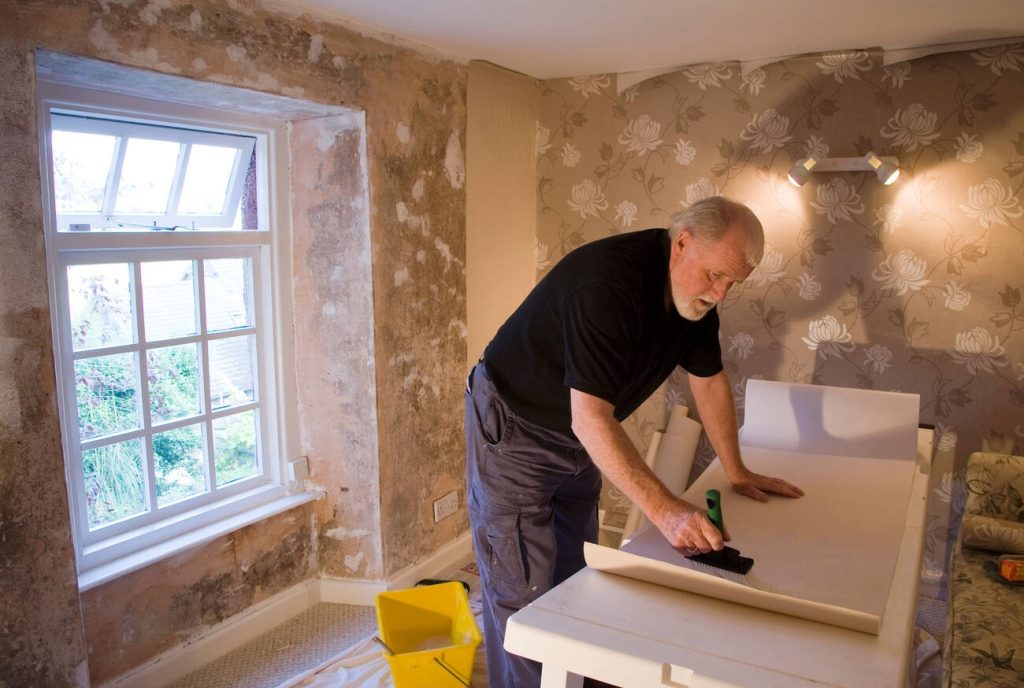When it comes to choosing wallpaper for your home, one of the first decisions you’ll need to make is whether to go with pre-pasted or unpasted wallpaper. Each type has its pros and cons, and knowing these differences helps you choose the best option for your needs. We’ll explore the key differences between pre-pasted and unpasted wallpapering and offer tips on choosing the right type for your project.
Pre-Pasted Wallpaper
Definition:
Pre-pasted wallpaper comes with adhesive already applied to the back, facilitating a straightforward installation process. This adhesive is typically activated by soaking it in water, ensuring a less messy application experience.
Advantages:
- Ease of Installation: The primary benefit of pre-pasted wallpaper is its ease of installation. Since the adhesive is already applied, you simply need to activate it with water.
- Less Mess: With pre-pasted wallpaper, there’s no need to deal with separate paste or glue, reducing the potential for mess.
- Time-Saving: The preparation process is quicker compared to unpasted wallpaper, making it a great option for DIY enthusiasts or those short on time.
Disadvantages:
- Adhesive Quality: The adhesive on pre-pasted wallpaper may not be as strong or durable as separate paste, which can affect its longevity and durability.
- Limited Adjustability: Once the adhesive is activated, you have a limited amount of time to position and adjust the wallpaper on the wall.
Installation Tips:
- Ensure the wall surface is clean and smooth before application.
- Follow the manufacturer’s instructions for soaking the wallpaper to properly activate the adhesive.
- Work quickly but carefully to position the wallpaper, smoothing out any air bubbles as you go.
Unpasted Wallpaper
Definition:
Unpasted wall coverings require the application of paste or glue to the back before they can be hung. This type provides more flexibility and is often preferred by professionals.
Advantages:
- Stronger Adhesion: Using a separate paste allows for stronger adhesion, making unpasted wallpaper more durable and long-lasting.
- Greater Control: You have more control over the amount and type of paste used, which can be beneficial for different wall surfaces and environmental conditions.
- Adjustability: Unpasted wallpaper offers more time to adjust and position it on the wall before the paste sets, reducing the risk of mistakes.
Disadvantages:
- More Preparation: Applying paste adds an extra step to the installation process, requiring more preparation and cleanup.
- Potential for Mess: Handling paste can be messy and may require additional tools and materials, such as a pasting table and brushes.
Installation Tips:
- Use a high-quality paste suitable for your specific wallpaper material.
- Apply an even layer of paste to the back of the wallpaper, ensuring full coverage.
- Allow the wallpaper to “book” (folded paste side to paste side) for a few minutes before hanging to activate the paste and make the paper more pliable.
How to Choose Between Pre-Pasted and Unpasted Wallpaper
When deciding between pre-pasted and unpasted wallpaper, consider the following factors:
- Skill Level: If you’re new to wallpapering or prefer a quicker, easier installation, pre-pasted options may be the better choice. For those with more experience or looking for a professional finish, unpasted varieties provide more control and durability.
- Project Size: For small projects or feature walls, pre-pasted options can save time and effort. Larger projects might benefit from the stronger adhesion and flexibility of unpasted versions.
- Wall Condition: Assess the condition of your walls. If they are smooth and in good shape, pre-pasted options should adhere well. For uneven or textured surfaces, unpasted paper with a strong adhesive is recommended for better results.
- Durability Needs: For high-traffic areas or rooms with higher moisture levels (like bathrooms or kitchens), unpasted wallpaper with a robust adhesive might be more suitable.
- Personal Preference: Ultimately, your personal preference and comfort level with the installation process should guide your decision. Consider doing a small test area with each type to see which one you find easier to work with.
Conclusion
Both pre-pasted and unpasted wallpapers offer unique benefits and challenges. By understanding these differences and your specific needs, you can choose the right option to enhance your space. A well-executed installation can transform your home, adding personal style whether you choose pre-pasted or unpasted options.
Our company SK GROUP NYC CORP is reaching out to individuals seeking professional wallpapering services. We offer expert wallpaper installation for any space—home renovations, office updates, or new property decor. Our team specializes in both pre-pasted and unpasted wallpapering applications, ensuring meticulous attention to detail and a flawless finish. Trust us to enhance your space with quality craftsmanship and a wide range of design options. Contact us today to discuss your project and let our experienced professionals bring your vision to life with precision and care.

